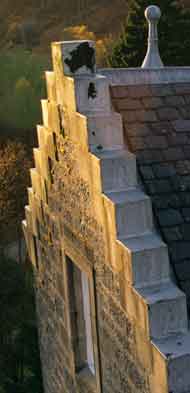












The top of the parapet wall projects above the roofline and the top of the brick or stone wall is stacked in a step pattern above the roof as a decoration and as a convenient way to finish the brick courses.
Early examples, from the 15th century onward, are found in England, Denmark, Germany, Switzerland, and Sweden. Crow-stepped gables were also used in Scotland as early as the 16th century. [1] Examples of Scottish crow-stepped gable can be seen at Muchalls Castle, Monboddo House and the Stonehaven Tolbooth, all late 16th and early 17th century buildings. Crow-stepped gables are also common on Danish medieval churches.
In the Dutch language, this design is termed trapgevel or "stair-step gable", characteristic of many brick buildings in the Netherlands, Belgium and in Dutch colonial settlements. 19th century examples are found in North America, and the step gable is also a feature of the northern-renaissance revival styles.
By Appointment
PARIS CERAMICS
South Park Studios - Suite 10
88 Peterborough Road, London SW6 3HH
United Kingdom